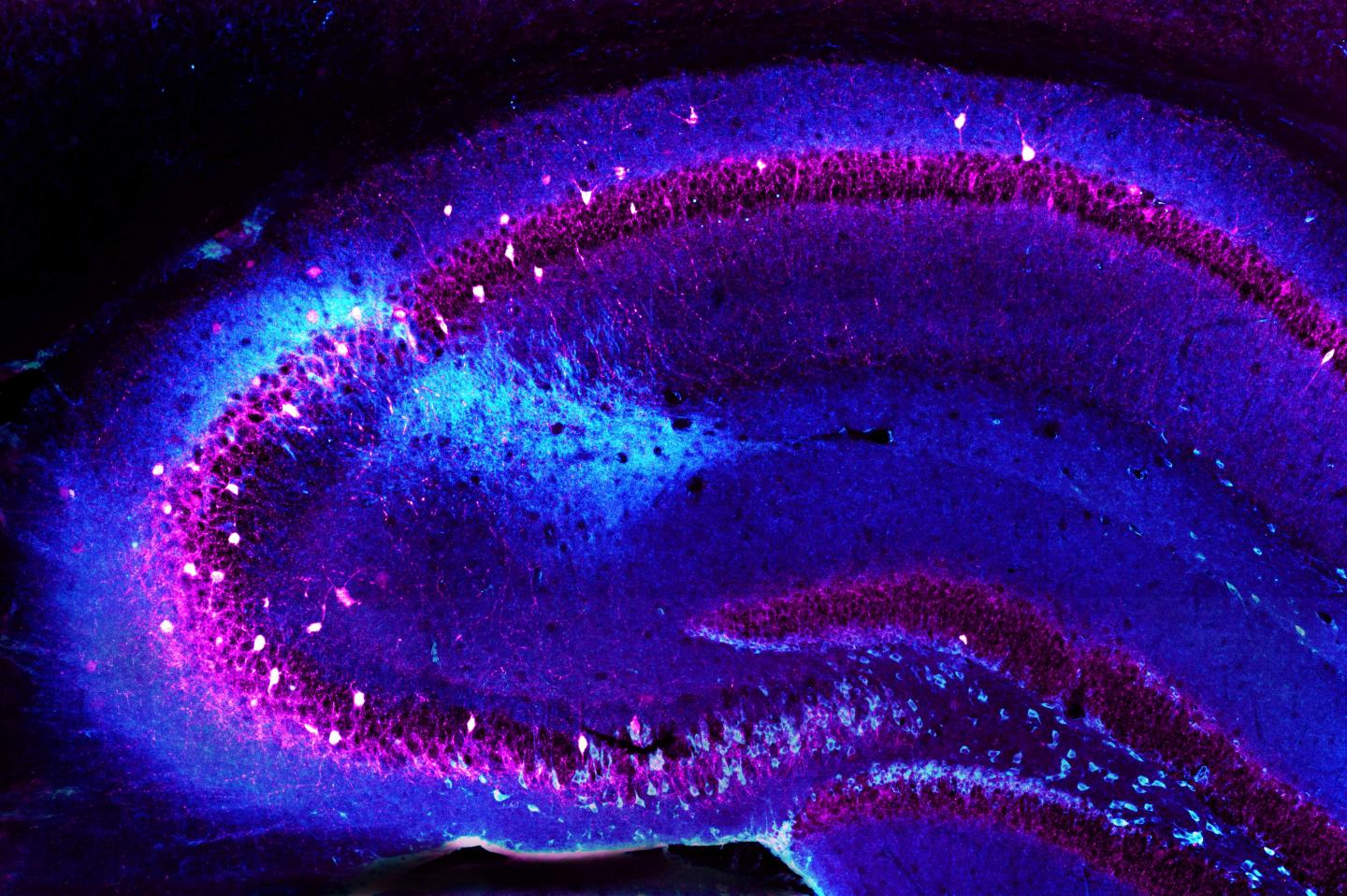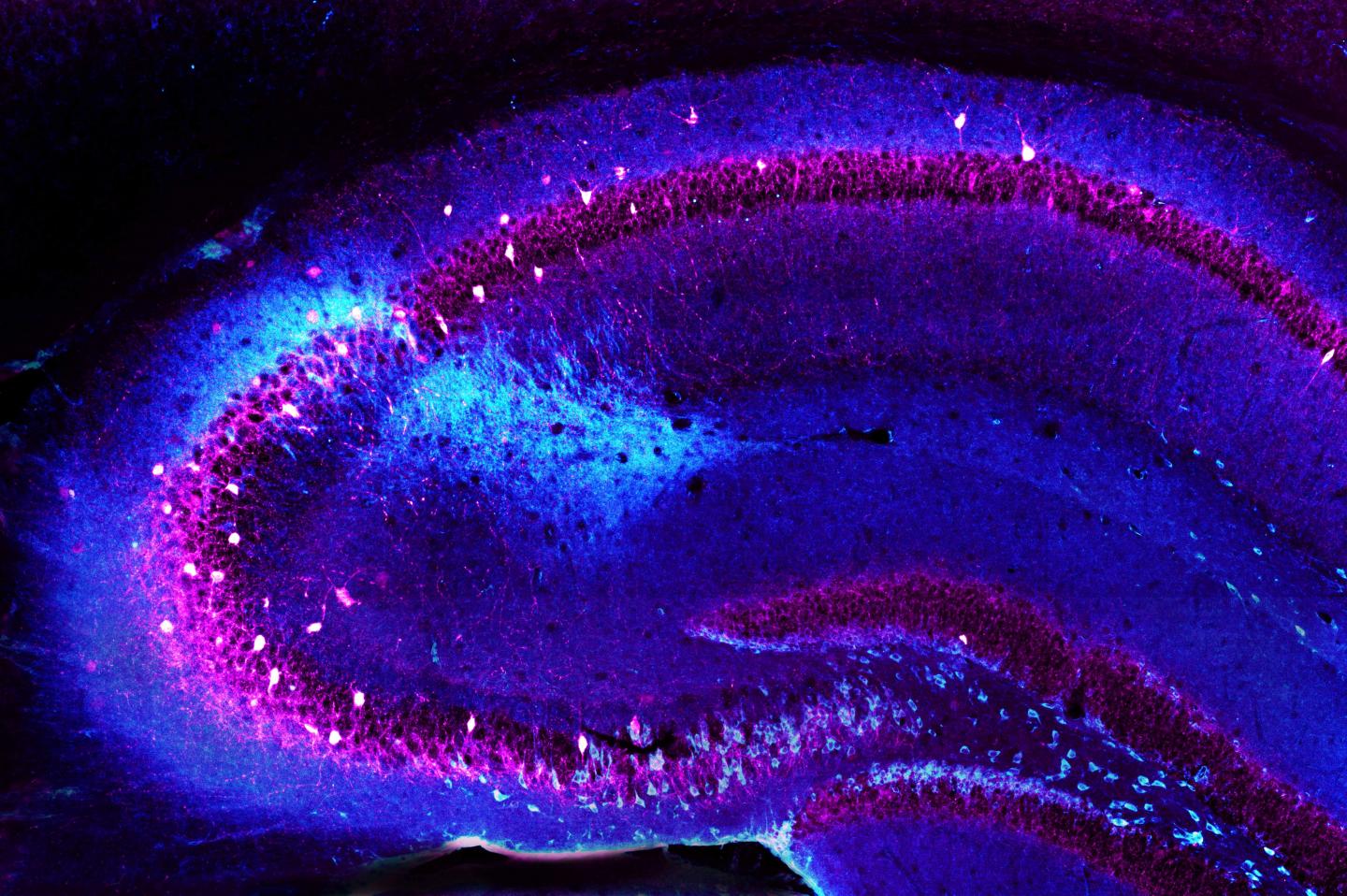
IMAGE: This is an image of the mouse hippocampus, with CA2 inhibitory neurons stained in light blue. In the researchers' mouse model of schizophrenia, this region showed significant depletion of neurons…
Credit: Vivien Chevaleyre
New York, NY, January 6, 2015–Scientists at Columbia University's Mortimer B. Zuckerman Mind Brain Behavior Institute, Columbia University Medical Center (CUMC), and the Université Paris Descartes have found that deficits in social memory–a crucial yet poorly understood feature of psychiatric disorders such as schizophrenia–may be due to a decrease in the number of a particular class of brain cells, called inhibitory neurons, in a little-explored region within the brain's memory center.
The findings, which were reported today in the journal Neuron, explain some of the underlying mechanisms that lead to the more difficult-to-treat symptoms of schizophrenia, including social withdrawal, reduced motivation and decreased emotional capacity.
Scientists have long speculated that schizophrenia, which affects about 1 in every 100 adults worldwide, originates in part in the hippocampus–the brain's headquarters for memory and spatial navigation. As a result, nearly every region of the hippocampus has been studied extensively in the hopes of gaining insight into the disorder. One notable exception is a tiny region of the hippocampus known as CA2.
"Smaller and less well-defined than other parts of the hippocampus, CA2 was like a small island that was depicted on old maps but remained unexplored," explained Vivien Chevaleyre, PhD, group leader in neuroscience at the Université Paris Descartes and a lead author of the paper.
Several discoveries have focused attention on a possible association between CA2 and schizophrenia. This region of the hippocampus is associated with vasopressin, a hormone that plays a role in sexual bonding, motivation and other intensely social behaviors, which become impaired in people with the disorder. In addition, postmortem examinations of people with schizophrenia have revealed a marked decrease in the number of CA2 inhibitory neurons, while the rest of the hippocampus remained largely unaffected. However, the significance of this loss had remained unclear.
In this study, the researchers performed a series of electrophysiological and behavioral experiments on a mouse model of schizophrenia developed at CUMC.
By examining the brains of these mice, the researchers observed a substantial decrease in inhibitory CA2 neurons, as compared to a control group of normal, healthy mice–a change remarkably similar to that previously observed in postmortem examinations of people with schizophrenia. Moreover, the team discovered that the modified mice had a significantly reduced capacity for social memory compared with the controls. This raises the hypothesis that changes to CA2 may account for some of the social behavioral changes that occur in individuals with the disorder.
"Even the timing of the emergence of symptoms in the mice–during young adulthood–parallels the onset of schizophrenia in humans," said Joseph Gogos, PhD, a professor of physiology and neuroscience at CUMC, a principal investigator at the Zuckerman Institute and a lead author of the paper.
"We can now examine the effects of schizophrenia at the cellular level and at the behavioral level," said Steven Siegelbaum, PhD, chair of the Department of Neuroscience at CUMC, a principal investigator at the Zuckerman Institute and a co-author of the paper. "This essentially opens up a whole new avenue for research that could lead to earlier diagnosis and more effective treatments for schizophrenia."
###
This paper is titled: "Age-dependent specific changes in area CA2 of the hippocampus and social memory deficit in a mouse model of the 22q11.2 deletion syndrome." Rebecca A. Piskorowski, PhD, was the project group leader and the first author of this paper. Additional contributors include Kaoustar Nasrallah, PhD, at Université Paris Descartes and Anastasia Diamantopoulou, PhD, Jun Mukai, MD, PhD, and Sami I. Hassan, PhD at CUMC.
This research was supported by the CNRS ATIP-Avenir, Agence Nationale de la Recherche (ANR-12-BSV4-0021-01, ANR-13-JSV4-0002-01), the Ville de Paris and the National Institutes of Health (MH097879).
The authors report no financial or other conflicts of interest.
About the Zuckerman Institute
Grasping the implications for the health of the brain, mind, and nervous system is perhaps the greatest challenge facing 21st-century science. To lead the way, Columbia University has established a comprehensive institute for the pursuit of interdisciplinary and collaborative research in brain science. Building on the University's distinguished history in the study and treatment of the brain, the Mortimer B. Zuckerman Mind Brain Behavior Institute will bring together 1,000 scientists in a single state-of-the-art engine of discovery–based at the Jerome L. Greene Science Center–now rising on the University's new Manhattanville campus. It will form the hub of an even larger collaborative network of academics stretching across all disciplines–including the arts, economics, law, and medicine–and campuses, from Columbia University Medical Center to Morningside Heights and beyond. To learn more, visit zuckermaninstitute.columbia.edu.
Columbia University Medical Center provides international leadership in basic, preclinical, and clinical research; medical and health sciences education; and patient care. The medical center trains future leaders and includes the dedicated work of many physicians, scientists, public health professionals, dentists, and nurses at the College of Physicians and Surgeons, the Mailman School of Public Health, the College of Dental Medicine, the School of Nursing, the biomedical departments of the Graduate School of Arts and Sciences, and allied research centers and institutions. Columbia University Medical Center is home to the largest medical research enterprise in New York City and State and one of the largest faculty medical practices in the Northeast. For more information, visit cumc.columbia.edu or columbiadoctors.org.
Media Contact
Anne Holden
[email protected]
212-853-0171
http://zuckermaninstitute.columbia.edu/





